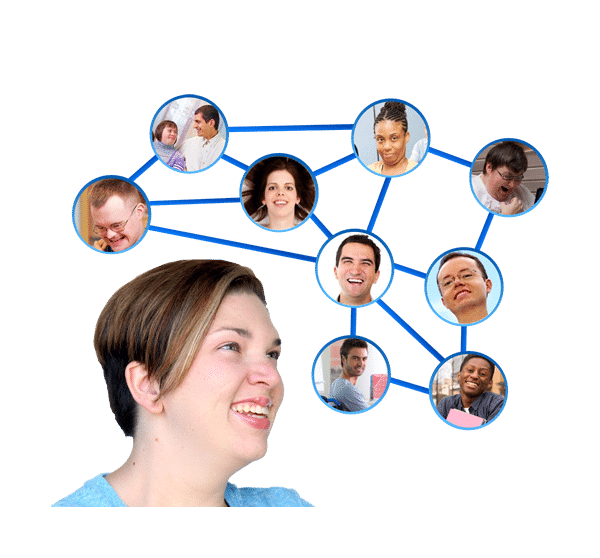Although it often gets lumped in with chronic “diseases,” cerebral palsy is not a disease. It is a condition that results from damage to areas of the brain responsible for movement a child experiences while they are in the womb or, in some cases, immediately after birth. Doctors can usually diagnose cerebral palsy, or CP, early on — during or not long after infancy.
Because cerebral palsy treatment and severity can look different for each person, developing a plan for how to care for your loved one with this condition or how to help someone with CP is a critical part of helping them manage it throughout childhood and adulthood. No matter how much you love someone, caring for a child or adult with cerebral palsy is stressful. It puts a lot of pressure on you every day. And, if you aren’t careful, the ins and outs of figuring out how to manage your loved one’s symptoms can quickly become overwhelming.
While we can’t cure cerebral palsy or suddenly make all your stressors disappear, specific strategies and products can help make your job as a caregiver just a little bit easier.
What Is Cerebral Palsy?
Cerebral palsy is a condition that results when a child experiences brain damage in the womb or immediately after birth. Marked by problems related to movement, muscle tone and posture, its effects are permanent.

The severity of cerebral palsy can vary, providing challenges that are unique for every caregiver. Some people with cerebral palsy can walk on their own, while others must rely on a wheelchair. Some can communicate their needs, and others are non-verbal. While cerebral palsy itself is a neurological condition, it can lead to a variety of other problems for individuals. While each person is different, in general, someone with cerebral palsy is also more likely to struggle with:
- Abnormal perceptions of touch or pain
- Seizures
- Cognitive issues
- Hearing and vision problems
- Incontinence
- Intellectual disabilities, including ADD and ADHD
- Oral diseases
- Mental health conditions
An individual with CP does face a unique set of challenges, but in today’s world, there many tools and strategies available to help them progress and live happy, productive lives. In many cases, they can make significant strides toward independence, which also relieves some of the pressure on their caregivers.
As a caregiver for someone with cerebral palsy — whether child or adult — you are always looking for ways to help your loved one improve their overall health and well-being. At Enabling Devices, we understand care for cerebral palsy in the home is an ongoing process of education and discovery. You never stop growing and learning, because you are determined to do the best you can as you care for your loved one.
Making Daily Life Easier
When it comes to at-home care for cerebral palsy, there are a lot of products and strategies available to help make life easier. Knowing what’s out there and how it can help you is essential to provide care for someone you love successfully.
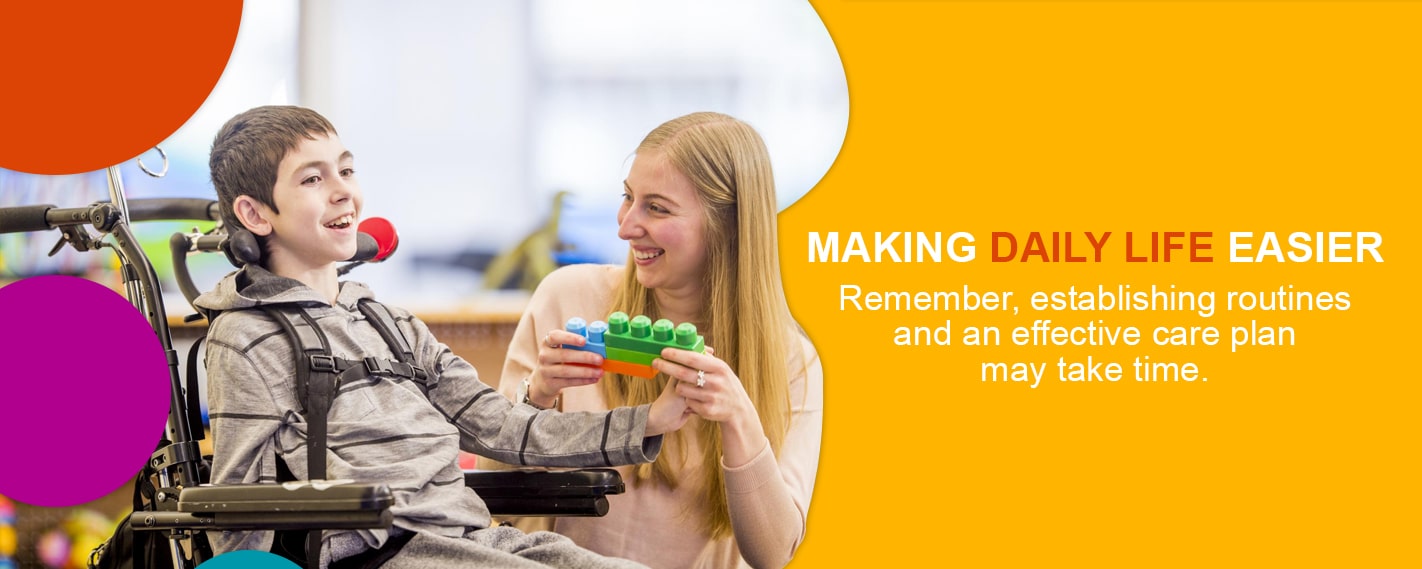
Remember, establishing routines and an effective care plan may take time. After all, figuring out what works best doesn’t usually happen overnight. There will be times of trial and error before you finally settle on what works. You may spend months trying a new product or strategy, only to discover a better option down the road.
CP is a lifelong condition, so taking time to try different strategies and developing a plan that works for your loved one’s unique challenges is the best way to make sure everyone is comfortable and thriving where they are.
As you strive toward this, it’s essential to take time for self-care. Find ways to relieve stress, ask for help — more about that later — and remember to rest. One of the best cerebral palsy caregiving tips is to make sure you are helping yourself, too.
Communication and Language Development
One unique challenge that accompanies caring for someone with cerebral palsy is encouraging communication and language development. While cerebral palsy itself is typically a condition that affects movement, it can have profound cognitive impacts as well. Because of the limitations on their muscle development and function, individuals with cerebral palsy may struggle with facial expressions, gestures, speech, voice production and language — that is, being able to communicate and express their needs in a clear, concise way.
When it comes to how to raise a child with cerebral palsy, one vital job of caregivers is to address these issues when children are young, so as they grow, they learn to communicate and function in the world around them.
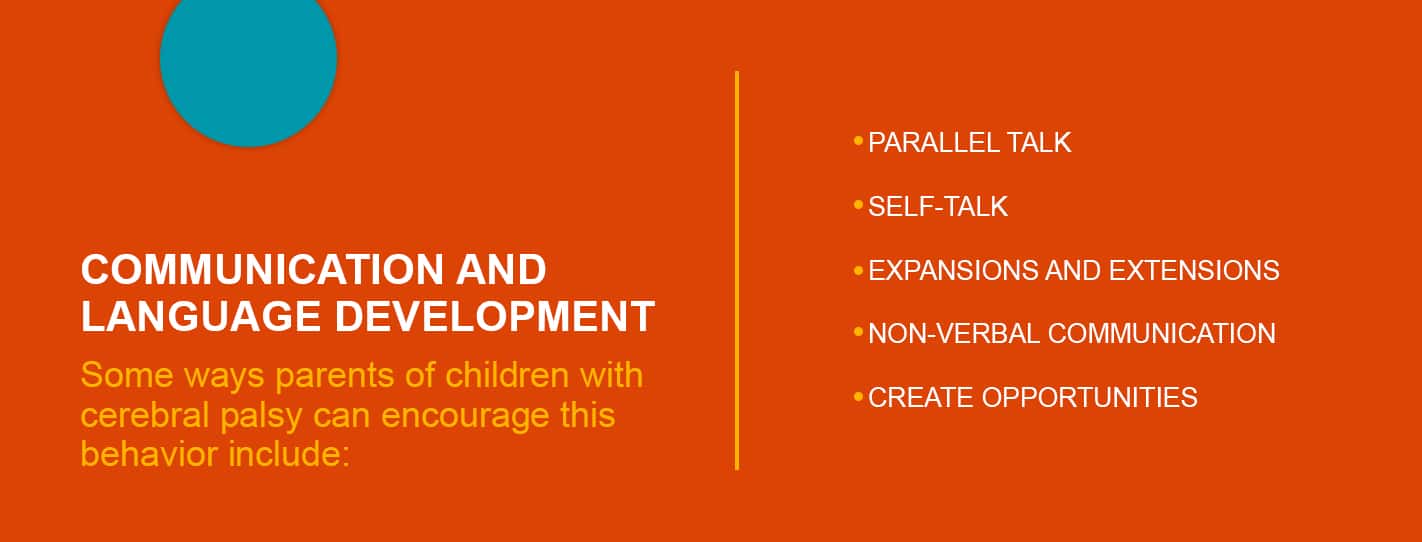
Some ways parents of children with cerebral palsy can encourage this behavior include:
1. Parallel Talk
This strategy is simple. As your child performs an activity — for example, playing with wooden blocks — you, the parent, talk about what’s happening while they do it. As they play, you might say, “Oh, look, you’re building with blocks. You put the red on top of the blue. Oh no, they fell over!” Think of it as narrating your child’s activities.
2. Self-Talk
This method is similar to parallel talk, only you are narrating what you as the parent are doing, rather than observing your child. As you play with your child, talk about what you are doing. For example, as you play with blocks, you might say, “Here is a yellow block. I think I will put it on top of the red block. Look at that! The red block is shaped like a square.”
3. Expansions and Extensions
In this case, you as the caregiver can add on to your child’s vocabulary to help them expand it. For example, if your child says “Dog,” you can expand it by saying “Fluffy dog.” Or, you can extend it to say, “The man is walking the dog.”
4. Non-Verbal Communication
Non-verbal communication falls into two categories — assisted and unassisted. Assisted includes technologies designed to help non-verbal individuals express themselves, such as computers, speech synthesis machines, or Augmentative & Alternative Communicators (AAC). Enabling Devices has dozens of AAC devices. These devices can be as simple as a one-message communicator, multiple message communicators, or progressive communicators that grow with your child. Unassisted includes communication methods such as sign language. If your child is non-verbal, trying out some of these options can ease frustrations and provide a means for communication.
5. Create Opportunities
Sometimes, the best way to encourage a child’s communication is to give them opportunities to practice. Place a favorite toy just out of their reach, so they will have to ask for it. Or, encourage them to socialize with other people. The more opportunities they have to practice communication, the better they will become at expressing their thoughts, feelings and opinions.
Developing Hand/Eye Coordination and Fine Motor Skills
Hand/eye coordination is an essential function for someone with cerebral palsy. As the use of visual cues to direct and engage the hands in action, hand/eye coordination can be challenging for someone with cerebral palsy because it requires the simultaneous use of the vision system as well as the hands and muscles.
Often mentioned in tandem with fine motor skills, which require tiny muscle movements, hand/eye coordination is the development of the skill of using the vision system and hand muscles simultaneously.
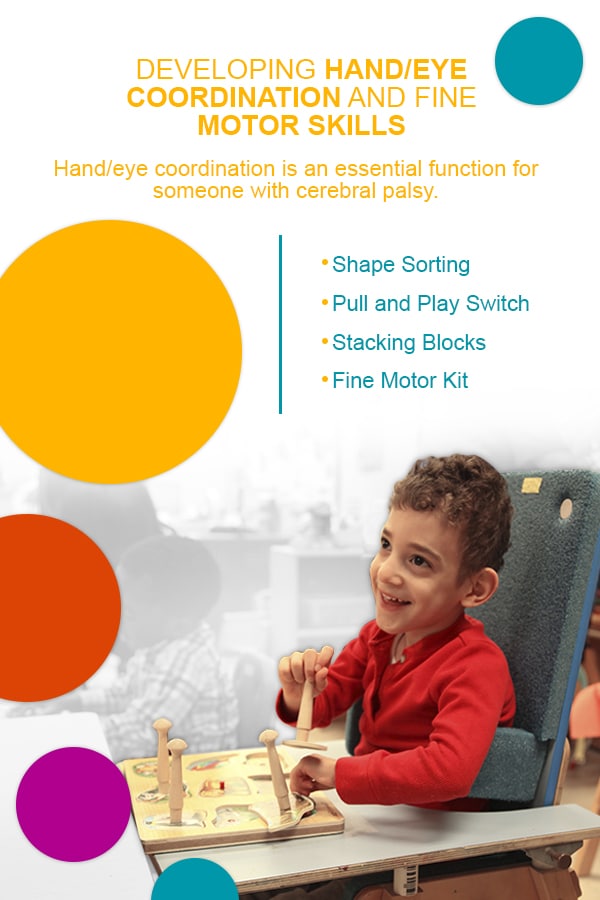
One of the best ways to help your loved one develop in one or both of these areas is with one of Enabling Devices’ assistive technologies. These devices provide fun and, often, guided interaction between the individual and their caregiver to help people with cerebral palsy in their development. The goal of these devices is to improve hand/eye coordination, as well as assist individuals with cerebral palsy as they develop and improve their fine motor skills.
1. Shape Sorting
Reminiscent of a popular child’s toy, this low-profile shape sorter — fondly called Drop-in-a-Bucket — is designed for players who have a more limited reach. The bucket has lights on it to attract the user’s attention, as well as music that plays when the user drops the shape into the correct hole. One great thing about this is that it teaches object placement and hand/eye coordination, as well as shape recognition. That combines two crucial functions into one item!
2. Pull and Play Switch
The Pull and Play Switch encourages the practice of three important motions — swiping, grasping and reaching. It can attach to a tabletop, wheelchair or bed rail, and comes with two different sized pulls. The object of the game is to encourage the player to reach for the ball suspended from the frame and then grab on to it with a finger or hand.
3. Stacking Blocks
These Stacking Blocks are designed to develop several skills vital to an individual with cerebral palsy. The object is to hone fine motor skills by placing one block at a time on the stack until it’s complete. As the individual places blocks onto the stack, they can also work on addition and subtraction and hand/eye coordination as they work to use their hands to guide the blocks to the right place.
4. Fine Motor Kit
Two Fine Motor Kits include different items that are designed to help children and teenagers strengthen their fingers and hands, develop grasping skills and hone their fine motor skills. It contains two pairs of easy-grip scissors, several games and the teen kit even has a Glow-in-the-Dark Dreamcatcher.
Daily Living Tasks
Another challenge caregivers often face is enabling your loved one with cerebral palsy to complete daily tasks. Generally speaking, four main tasks comprise the category of daily living — personal hygiene, eating/drinking, dressing and using the bathroom.
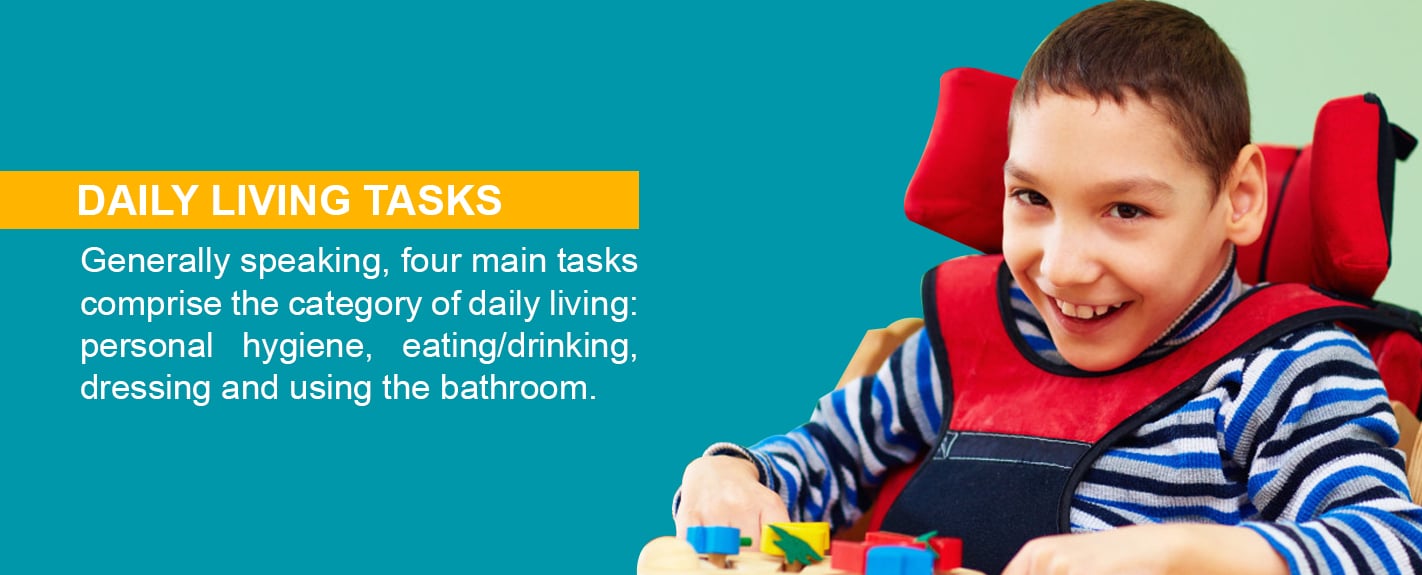
While the extent of a person’s CP will indeed dictate their ability to perform any of these four activities, it should be the goal of any caregiver to promote as much independence as possible to build and maintain muscle function, as well as for peace of mind. Caregivers cannot be present every second of every day, and teaching an individual with cerebral palsy to perform specific tasks on their own can give them a sense of independence, as well as provide a much-needed respite for you.
Your medical team can provide guidance on how to go about teaching and developing certain skills within an individual with cerebral palsy, but it is critical to find ways to incorporate instruction into daily activities when raising a child with cerebral palsy. For example, use mealtime as a time to gradually teach your loved one to feed themselves. To do this, you can prepare them ahead of time for the table setup, what utensils they will use and what they will be eating. Then, during the meal, work with them on correct posture and the mechanics of chewing, if necessary, as well as identifying unfamiliar foods and the proper way to eat.
There are also a variety of useful products on the market that focus on how to help someone with cerebral palsy as they develop muscle control and the ability to perform daily living tasks. For example, tools like Enabling Devices’ ADL Boards help individuals with cerebral palsy develop the skills they need to dress. Each of the four boards helps with mastery of manipulative skills, including buttons, snaps, laces and zippers.
Over time, if a person’s abilities allow, they can also begin to practice and master specific life skills — that is, skills that help them care for themselves on more than a basic level. These skills might include housework, meal preparation, communication, managing finances and shopping. They can also include pursuing hobbies and activities that are of interest to the individual.
Depending on their abilities, products such as Enabling Devices’ battery-powered scissors provide electronic cutting, promoting independence and allowing someone with limited mobility to cut paper, fabric and other items on their own. While a pair of scissors might seem like no big deal, to a person with physical limitations, the ability to use an everyday object like a pair of scissors can provide a much-needed boost in their self-esteem and joy.
Products for Sensory Needs
Along with the physical challenges that come with cerebral palsy, individuals with this condition can also struggle with sensory processing disorder. While a sensory processing disorder can manifest itself in many different ways, it means they have a heightened sensitivity to things in their environment. These could include fear of loud noises, sensitivity to scratchy fabrics or even failure to respond when they encounter extreme temperatures. Yes, everyone hates startling sounds or the tastes of certain foods, but, for an individual with a sensory processing disorder, these aversions can take on an exaggerated effect to the point where they have a negative physical response to a trigger, such as vomiting when a loud noise happens.
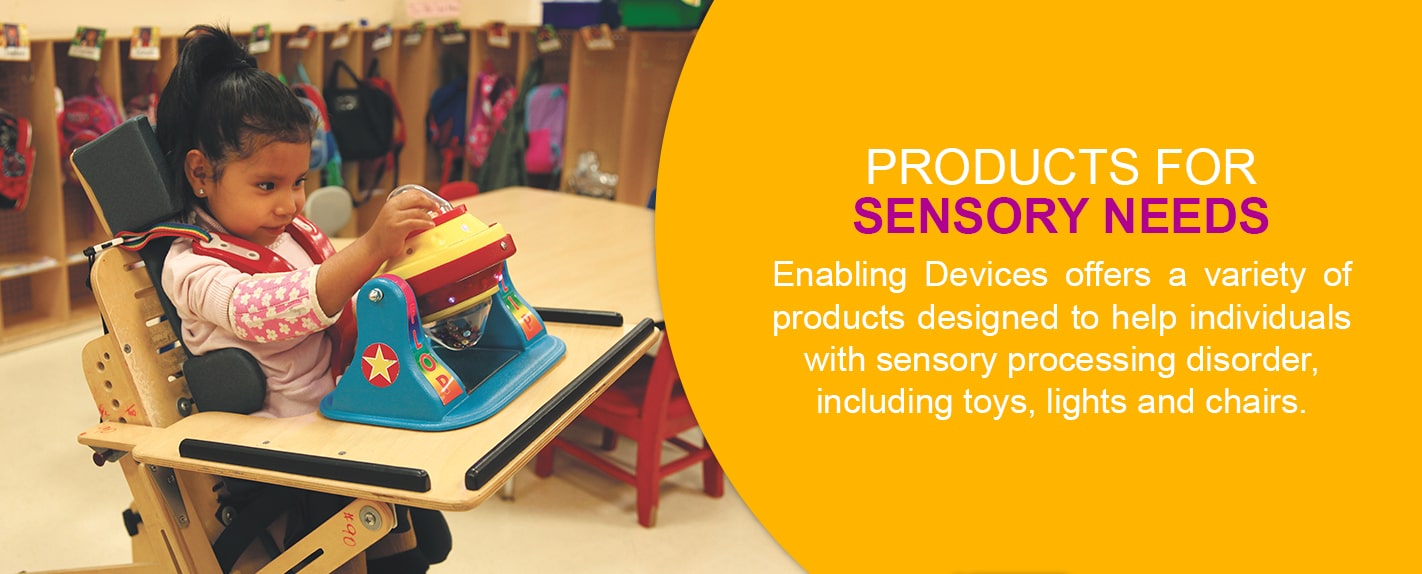
Enabling Devices offers a variety of products designed to help individuals with sensory processing disorder, including toys, lights and chairs. We also provide sensory room design services to connect families with special needs to trained professionals who can recommend designs and products tailored to their individual needs.
Essential Products and Adapted Devices
One especially significant tool for individuals with cerebral palsy is the adaptive switch, a button used to activate adapted devices. The size and technology behind switches vary, so there is something out there for individuals of all levels of disability. These switches can make it possible for individuals with cerebral palsy to access a variety of devices including communicators, adapted toys, adapted electronics and even iPads. Enabling Devices has dozens of switches that address a wide range of needs — head switches, hand switches, sip & puff switches, mounted switches, and even an eye blink switch.

Caregivers can attach switches to mounts, which come in a variety of sizes and designs. The job of a mount is to position a switch in a way that makes it most accessible for a particular individual based upon their physical needs. These can make a huge difference for an individual with limited physical abilities.
What good would switches and mounts be without adapted devices that attach to them? Enabling Devices offers hundreds of adapted devices that work with our switches. These include:
Finding Help
Being the parent of a child or adult with cerebral palsy can be both physically and mentally demanding. Just as you are intentional about taking good care of your loved one, you should also be intentional about taking care of yourself. Caregiver burnout can result in depression, anxiety and a variety of mental and physical health issues.
Unfortunately, all the devices and assistive technology in the world cannot prevent a caregiver from overdoing it. As a caregiver, you have a responsibility to yourself, as well as your loved one, to ask for help. This assistance could be in the form of a babysitter who comes once a week while you go to a movie, or it could be a trained professional who takes a more frequent and active role in the day-to-day care of your loved one.
Whatever route you decide to take, you will likely feel some apprehension about allowing someone else to spend time with your child without you present — no matter how old your child is. Some anxiety is normal, especially in the beginning. But, as you adapt to the presence of another person, it’s important to remember:
1. Change Is Good
Your child can find happiness and a fresh perspective when they spend a few hours with someone else. Interacting with a new person, encountering different ideas and playing various games can be stimulating for them, as well as you.
2. Taking Care of Yourself Helps Your Family
By avoiding caregiver burnout, you keep yourself mentally sharp and ready to care for your family, which is particularly vital if you have others in your home who do not have cerebral palsy. When you a break from your responsibilities as a caregiver, you can pay better attention to your other family members and nurture relationships that might otherwise fall by the wayside.
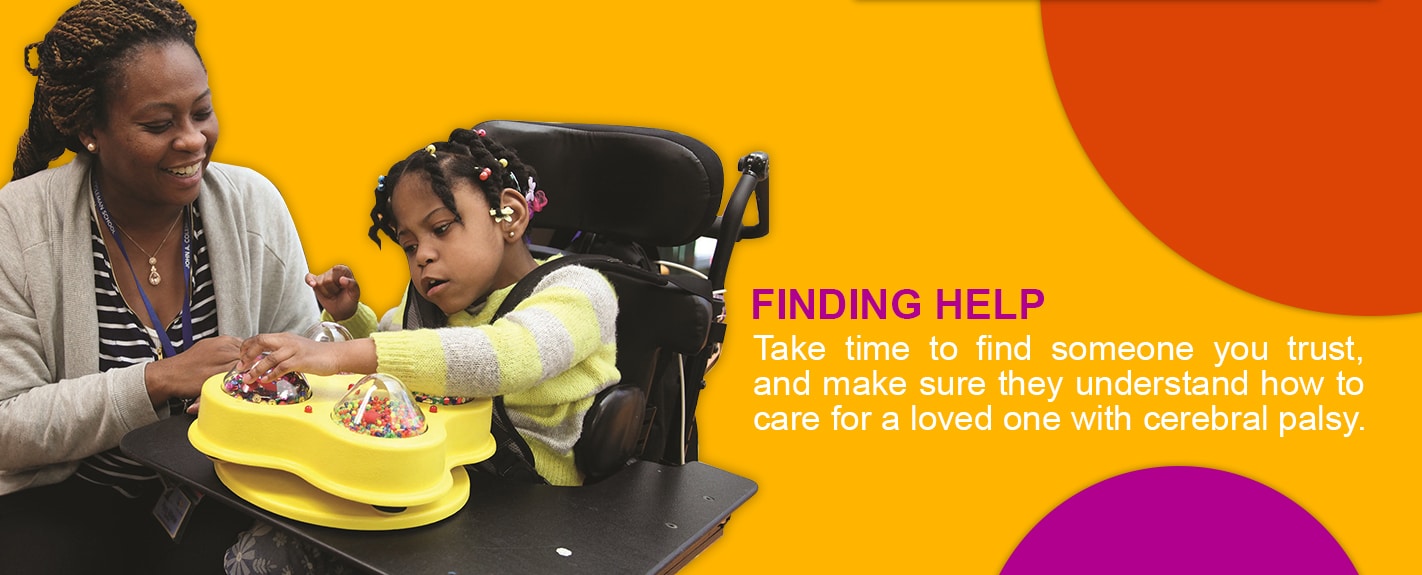
Just because it’s important to get help doesn’t mean you’ll leave your loved one with the first person you find. Take time to find someone you trust, and make sure they understand how to babysit a child with cerebral palsy. Then, once you’ve hired someone, spend time with them outlining expectations and routines. Be clear about what you expect, and make sure you know what their expectations are too.
About Enabling Devices
Since our founding in 1978, Enabling Devices has been dedicated to providing high-quality, individualized service to our clients and their families. Our goal goes beyond providing products to perform a task or assist with a daily function. Our mission is to create products that allow our clients to unlock their full potential and experience joy and independence they didn’t think was possible.

Enabling Devices is proud to serve clients with a variety of needs, including clients with cerebral palsy. We offer a wide range of products to provide accessibility and to address muscle development, sensory issues, fine motor skills, teach cause and effect, and much more.
For questions about our products or to place an order, contact us today at 800-832-8697.




















